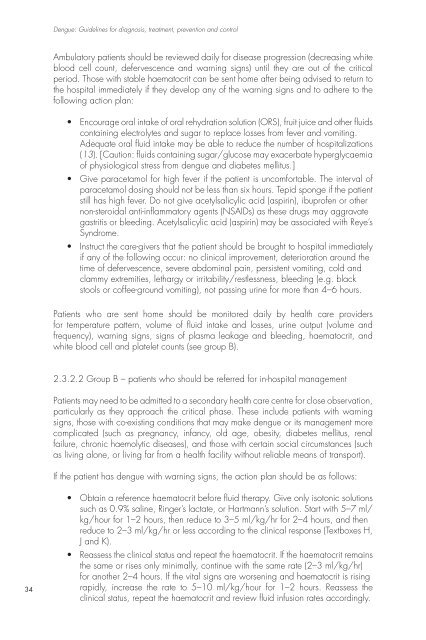dengue-diagnosis
dengue-diagnosis
dengue-diagnosis
Create successful ePaper yourself
Turn your PDF publications into a flip-book with our unique Google optimized e-Paper software.
Dengue: Guidelines for <strong>diagnosis</strong>, treatment, prevention and control<br />
Ambulatory patients should be reviewed daily for disease progression (decreasing white<br />
blood cell count, defervescence and warning signs) until they are out of the critical<br />
period. Those with stable haematocrit can be sent home after being advised to return to<br />
the hospital immediately if they develop any of the warning signs and to adhere to the<br />
following action plan:<br />
• Encourage oral intake of oral rehydration solution (ORS), fruit juice and other fluids<br />
containing electrolytes and sugar to replace losses from fever and vomiting.<br />
Adequate oral fluid intake may be able to reduce the number of hospitalizations<br />
(13). [Caution: fluids containing sugar/glucose may exacerbate hyperglycaemia<br />
of physiological stress from <strong>dengue</strong> and diabetes mellitus.]<br />
• Give paracetamol for high fever if the patient is uncomfortable. The interval of<br />
paracetamol dosing should not be less than six hours. Tepid sponge if the patient<br />
still has high fever. Do not give acetylsalicylic acid (aspirin), ibuprofen or other<br />
non-steroidal anti-inflammatory agents (NSAIDs) as these drugs may aggravate<br />
gastritis or bleeding. Acetylsalicylic acid (aspirin) may be associated with Reye’s<br />
Syndrome.<br />
• Instruct the care-givers that the patient should be brought to hospital immediately<br />
if any of the following occur: no clinical improvement, deterioration around the<br />
time of defervescence, severe abdominal pain, persistent vomiting, cold and<br />
clammy extremities, lethargy or irritability/restlessness, bleeding (e.g. black<br />
stools or coffee-ground vomiting), not passing urine for more than 4–6 hours.<br />
Patients who are sent home should be monitored daily by health care providers<br />
for temperature pattern, volume of fluid intake and losses, urine output (volume and<br />
frequency), warning signs, signs of plasma leakage and bleeding, haematocrit, and<br />
white blood cell and platelet counts (see group B).<br />
2.3.2.2 Group B – patients who should be referred for in-hospital management<br />
Patients may need to be admitted to a secondary health care centre for close observation,<br />
particularly as they approach the critical phase. These include patients with warning<br />
signs, those with co-existing conditions that may make <strong>dengue</strong> or its management more<br />
complicated (such as pregnancy, infancy, old age, obesity, diabetes mellitus, renal<br />
failure, chronic haemolytic diseases), and those with certain social circumstances (such<br />
as living alone, or living far from a health facility without reliable means of transport).<br />
If the patient has <strong>dengue</strong> with warning signs, the action plan should be as follows:<br />
34<br />
• Obtain a reference haematocrit before fluid therapy. Give only isotonic solutions<br />
such as 0.9% saline, Ringer’s lactate, or Hartmann’s solution. Start with 5–7 ml/<br />
kg/hour for 1–2 hours, then reduce to 3–5 ml/kg/hr for 2–4 hours, and then<br />
reduce to 2–3 ml/kg/hr or less according to the clinical response (Textboxes H,<br />
J and K).<br />
• Reassess the clinical status and repeat the haematocrit. If the haematocrit remains<br />
the same or rises only minimally, continue with the same rate (2–3 ml/kg/hr)<br />
for another 2–4 hours. If the vital signs are worsening and haematocrit is rising<br />
rapidly, increase the rate to 5–10 ml/kg/hour for 1–2 hours. Reassess the<br />
clinical status, repeat the haematocrit and review fluid infusion rates accordingly.


